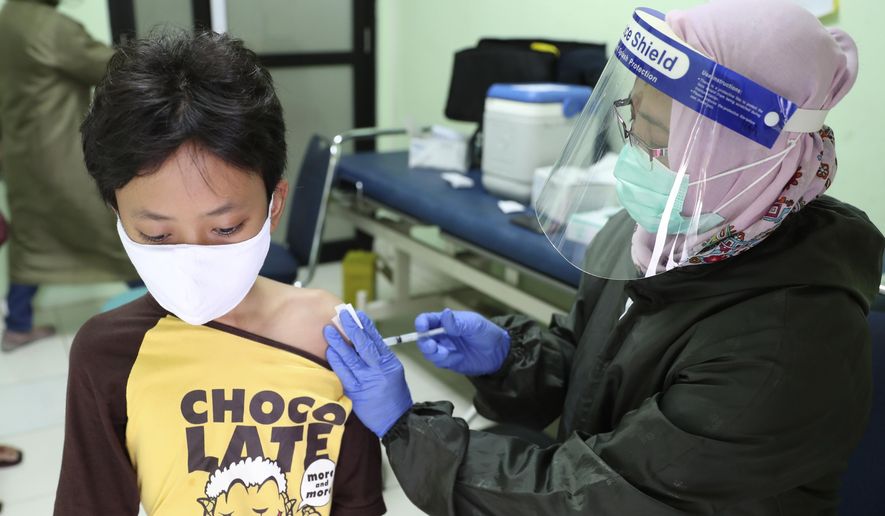Some 23 million children globally missed out on routine vaccinations — the most in more than a decade — due to service disruptions from the COVID-19 pandemic, the World Health Organization and the U.N. Children’s Emergency Fund (UNICEF) reported Thursday.
Up to 17 million children likely did not receive a single vaccine during the year, the agencies found. Most of the children who missed routine vaccinations live in areas affected by conflict, underserved remote places or in slums where there is limited access to basic health and social services.
Compared with 2019, 3.5 million more children missed their first dose of the diphtheria, tetanus and pertussis (DTP) vaccine, while 3 million more children didn’t receive their first measles dose.
Health officials say children should receive their first dose of the measles vaccine between 12 and 15 months of age and their first doses of the DTP vaccine before age 7.
The majority of countries saw drops in childhood vaccination rates in 2020. However, countries in Southeast Asian and Eastern Mediterranean regions were most affected by disruptions to immunization services, data shows.
India had the highest increase in children missing their first dose of the DTP vaccine. In 2020, 3,038,000 kids in India did not receive the first dose of the DTP vaccine, up from 1,403,000 children in 2019.
Pakistan was second, with 968,000 children missing the first dose last year, up from 567,000 from the previous year. Indonesia ranks third, with 797,000 kids not receiving the first dose in 2020, an increase from 472,000 in 2019.
UNICEF Executive Director Henrietta Fore said that countries were starting to “lose ground in the fight” to immunize children against preventable illnesses even before the pandemic, but that the pandemic has made “a bad situation worse.”
“This evidence should be a clear warning – the COVID-19 pandemic and related disruptions cost us valuable ground we cannot afford to lose – and the consequences will be paid in the lives and wellbeing of the most vulnerable,” Ms. Fore said Thursday in a statement.
The COVID-19 pandemic led to the diversion of resources and health care staff. Clinics have been closed or reduced their hours in some countries, and people might have avoided seeking health care due to fear of the virus’ spread or difficulty accessing care.
Middle-income countries make up an increasing proportion of children missing out on at least some vaccine doses, the report says.
For instance, India is experiencing a large drop, with DTP-3 vaccine coverage declining from 91% to 85%. In the Americas, vaccination coverage also is falling, with just 82% of children fully vaccinated with DTP, a drop from 91% in 2016.
WHO and UNICEF attribute the vaccination lag to funding shortfalls, vaccine misinformation and instability among other reasons.
Worldwide childhood vaccination rates against diphtheria, tetanus, pertussis, measles and polio stalled at around 86% for several years even before the COVID-19 pandemic.
The rate is below the 95% recommended to protect against measles, which is often the first disease to make a comeback when children are not vaccinated, and other vaccine-preventable illnesses, WHO said.
“This is a wake-up call – we cannot allow a legacy of COVID-19 to be the resurgence of measles, polio and other killers,” said Dr. Seth Berkley, CEO of Gavi, the Vaccine Alliance. “We all need to work together to help countries both defeat COVID-19, by ensuring global, equitable access to vaccines, and get routine immunization programs back on track. The future health and wellbeing of millions of children and their communities across the globe depends on it.”
In 2019, the U.S. had its largest measles outbreak since 1992, with 1,282 individual cases confirmed in 31 states, according to the Centers for Disease Control and Prevention. Most of the cases were among people who were not inoculated against measles.
Global health officials also brought attention to vaccinations that are not outbreak-prone diseases such as shots against human papillomavirus that protect girls against cervical cancer.
They said these vaccinations have been largely affected by school closures, and about 1.6 million more girls missed out on these shots last year. An estimated 13% of girls worldwide were vaccinated against HPV last year, down from 15% in 2019, the report says.
• Shen Wu Tan can be reached at stan@washingtontimes.com.




Please read our comment policy before commenting.